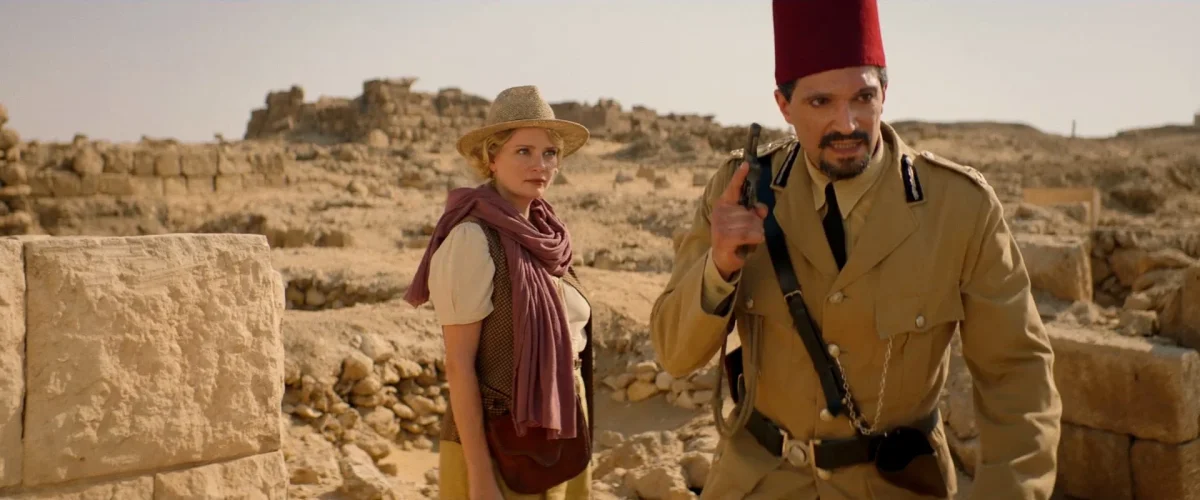Stephen Shimek’s Murder at the Embassy arrives like a sun-drenched postcard mailed straight from Agatha Christie’s universe—complete with an eccentric sleuth, a neatly contained circle of suspects, glamorous guests wearing polite but dubious smiles, and a murder that seems simple only until it reveals the bones of an empire. Yet here, the Nile itself seems to snake through the narrative like a withering stare, while colonial politics simmer beneath the veneer of proper dinner etiquette.
Miranda Green is not the sort of investigator who barrels into a case. She enters quietly, almost diffidently, letting her gaze drift and settle with clinical precision. She catalogues gestures, files away inconsistencies, and constructs patterns with her near-photographic memory. Miranda becomes the film’s calm gravitational force—a rational presence threading her way through colonial ego, long-buried secrets, and a conspiracy that stretches far beyond the confines of a single murder. And, as with any satisfying whodunit, the deeper she travels, the more the investigation shifts: the question is no longer who pulled the trigger, but who stands to profit from the ensuing silence.
Spoilers Ahead
Murder at the Embassy (2025) Plot Summary and Movie Synopsis
When the film opens, Miranda Green arrives in Cairo for what is supposed to be a pleasant diplomatic dinner at the British Embassy. She expects polite conversation, forced laughter, and political small talk, nothing more. The setting is lush and postcard-perfect: lantern-lit courtyards, the call to prayer humming in the distance, and the kind of elegant exoticism Western tourists photograph and misunderstand.
But the evening quickly introduces us to the cast locked inside this diplomatic dollhouse. Ambassador William, polished, paternal, politically anxious. Meghan, his daughter, is restless and emotionally watchful. Betty Hathaway, a Hollywood actress with a dazzling smile, hides a bruised conscience. Walter Cunningham, a journalist from The Daily Post, is observant and mildly smug. Laila, the translator, with quiet intelligence and a soft intensity. Mamoud Shoukry and Dandy, the embassy security pair. Samir, the loyal groundskeeper, whose loyalty soon becomes questionable. And Maggie, the secretary, whose brief appearance at dinner becomes the pivot of the entire mystery.
Dinner is lively in the way diplomatic dinners often are, everyone polite, everyone lying a little. Maggie steps in once to deliver a message to Walter, then leaves with her suitcase, presumably heading home. Hours later, she is found dead. Shot, bleeding, and alone in one of the embassy rooms. Suddenly, the colonial fantasy collapses. The embassy is not merely a diplomatic estate; it becomes a sealed crime scene. And instead of calling local police, the Ambassador quietly summons Miranda. Technically, the embassy is located on British soil. But beneath that choice lies another motive: avoiding Egyptian authorities who may expose more than just a murder.
Miranda enters the room and finds Maggie’s cold body and a scrap of paper in her hand with German, pro-Nazi writing. She immediately announces what the Ambassador dreaded. No one may leave since there is a Nazi sympathizer among the guests. From that moment, the film becomes a classic locked-room mystery layered with political tension.
What Events Lead Up to the Murder?
The film’s strength lies in how Miranda rewinds the evening, not through flashbacks, but through interrogations, contradictions, and the silent language of guilt. Meghan wasn’t in her room. She admits she was passing through the hallway when she saw her father stumble upon Maggie’s body. Meghan’s evasive tone is suspicious, but her panic comes from elsewhere. Her tension is emotional, not murderous.
Betty Hathaway headed to the kitchen, not her room. Suspicious, especially since she didn’t see Meghan despite crossing similar paths. However, Mamoud clarifies that there are two different passageways. Both women could be telling the truth. Walter wore a gold swastika earlier. He removed it before dinner. Miranda confronts him, but he insists it symbolizes the Hindu swastika gifted by a friend. A plausible explanation, yet something about his defensiveness feels off.
Maggie arrived at dinner carrying tension. She seemed anxious, purposeful. She delivered a message, left with a suitcase, and disappeared until her body reappeared at the embassy, dead. Every character had an opportunity. Everyone had a motive: jealousy, politics, secrecy, survival. And each person was lying in their own way. But Miranda doesn’t simply ask who pulled the trigger. Instead, she asks: Who benefits from Maggie’s silence?
Was Maggie a Nazi?
Miranda goes to Maggie’s off-site home and finds a woman named Rula ferrying Maggie’s suitcase toward a boat. Inside the bag are Maggie’s clothes, personal items, and most shockingly, a copy of Mein Kampf. This discovery throws Miranda off balance. If Maggie were a Nazi supporter, why would pro-Nazi forces kill one of their own? The logic crumbles.
The detective instinct kicks in: “If something makes sense too early, it’s a trap.” Miranda returns to the embassy unsettled. And then she sees something peculiar, another mysterious woman at the gate, turned away by security. Nothing about Maggie’s life adds up. Nothing about her death fits the neat Nazi-sympathizer narrative. Which means the evidence was meant to mislead.
How Do the Secret Tunnel and the Dig Site Change Everything?
While wandering the embassy gardens, Miranda finds a black cat statue. Its head moves. It’s not a decoration, but a mechanism, or a secret passage. This moment is pure Christie, eccentric, eerie, and deliciously theatrical. The tunnel leads Miranda and Mamoud into the underbelly of Cairo: a bustling souk that connects to Bastet Antique Shop. From there, their investigation traces Nazi artifacts to a specific dig site.
They ride camels across the desert to reach the dig site (an intentionally playful nod to old adventure cinema). There, tents wave with large Nazi flags, a shocking turn that pushes the story from drawing-room mystery into political thriller. And then the most startling twist, Samir, the harmless, soft-spoken caretaker, enters with a gun, and claims he killed Maggie.
He ties Miranda and Mamoud up. Samir aims the weapon at them. But Samir’s confession feels too eager, too scripted. Bullets suddenly ring out, but not from Samir. A group of young resisters, a secret anti-Nazi group called the Children of Giza, arrive and shoot him. The mystery becomes bigger than the embassy. Maggie wasn’t just a secretary caught in a political trap. She was a whistleblower trying to expose a conspiracy of weapons smuggling and colonial power. The question returns stronger: if Samir didn’t truly kill Maggie, then who did?
Who Actually Killed Maggie and Why?

Cristal, leader of the Children of Giza, reveals the real conspiracy. Maggie wasn’t a Nazi. She was trying to expose Nazis. She discovered that someone at the embassy was smuggling guns into Cairo. The smuggling ring aimed to support a future Nazi takeover, and the monarchy was fragile. The throne would soon pass to a 14-year-old prince. She also knows that a colonial power vacuum was brewing, and a Nazi-aligned faction wanted to seize the moment.
Cristal reveals that Maggie reached out to the Children of Giza weeks before. She arranged to give them proof through Arash, another member, whom Samir killed. Rula, the woman carrying the suitcase, wasn’t stealing from Maggie. She was trying to protect her. Everything Maggie did was out of fear and duty. Everything done to her was about silencing her.
Then Miranda pieces together the crucial detail. Samir couldn’t have returned through the one-way tunnel in time to kill Maggie. He was a middleman, a pawn. The real killer had to be someone powerful enough to cover tracks, threatened by Maggie’s knowledge, capable of manipulating Samir, present at the embassy, and above suspicion. All roads lead to one man: the Ambassador.
Why Does the Ambassador Kill Maggie?
Miranda revisits every interaction, every glance, and every line. She remembers a cheque book she glimpsed earlier, an account number tied to Maggie’s case, a torn scrap of paper in Maggie’s hand, the ambassador’s safe containing its matching half, his romantic relationship with Maggie, and Samir retrieving a gun from the flowerbed outside the ambassador’s window. Piece by piece, she reconstructs the night. The ambassador learned Maggie intended to expose his gun-smuggling deal with the Nazis, not only for money, but for maintaining colonial influence in Egypt during political upheaval. He confronted her.
She resisted, so he shot her. He fled through the window, dropping the gun. Samir found it. He tried to shoulder the blame. But he was only a small piece of a larger machine. Miranda, with her razor-sharp memory, lays out the crime cleanly, clinically, devastatingly. The Ambassador’s motives were: greed, political ambition, fear of exposure, and a desire to help a Nazi-aligned monarchy come to power. But the most damning reason? He thought he could get away with it because the Empire always protects its own.
Why Does the Inspector Ask Miranda to Keep a Secret?
Just when Miranda believes the case is fully resolved, the local police inspector arrives with an uncomfortable request: The Mein Kampf copy does not belong to Maggie. It belongs to Prince Edward, David, an affectionate name used within royal circles. This isn’t just a diplomatic scandal. It’s a breach high enough to crack the monarchy itself. If news spreads that a member of the royal family is a Nazi sympathizer, the entire British political structure collapses. The inspector asks Miranda to keep this secret. And she agrees. This moment reveals something powerful: even the best detectives cannot fight systems that were built to survive the truth.
Miranda exposes the murderer. She brings justice to Maggie. But the larger machine, Empire, monarchy, diplomacy, centuries of political choreography, remains untouched. It’s a sobering, Christie-like message: Justice is not the same as truth. Truth is not the same as exposure. And exposure is not the same as change.
Murder at the Embassy (2025) Movie Ending Explained:
Does Miranda Actually Win?
In the immediate sense, yes.
Miranda unmasks the killer. She saves herself, Mamoud, and the Children of Giza. She dismantles a weapon-smuggling conspiracy. Moreover, Miranda clears Maggie’s name. But in a broader sense, no. The royal family’s Nazi connections are hidden. The empire protects its own. And the roots of the conspiracy stretch further than a single ambassador. Miranda realizes that truth within political structures is not absolute; it is curated.
The film ends on a note that is not triumphant but contemplative. Miranda is brilliant, fierce, and morally consistent, but she is also human. She understands the cost of revealing a truth the world isn’t ready to confront. “Murder at the Embassy” does not attempt to surprise us with modern thrillers or a convoluted plot. Instead, it works with the classic whodunit format to present a single crime, a closed circle of suspects, a brilliant detective, and just the right amount of political themes that create a sting to the final reveal.
Miranda Green is a refreshing, old-school detective: studied, perceptive, empathetic, and filled with a slow-burning rage regarding injustice. She does not care for adrenaline, but clarity. And clarity is important to expose not only a murderer, but a political ecosystem pretending it does not exist, where it continues to hide its own murders. At the end, the mystery is solved. But the world around it remains unchanged.





![The Guilty [2021] Netflix Review – An Emotionally Taxing Crisis of Faith Wrapped In an Edge-of-the-seat Thriller](https://79468c92.delivery.rocketcdn.me/wp-content/uploads/2021/10/The_Guilty_Netflix-768x512.jpg)
